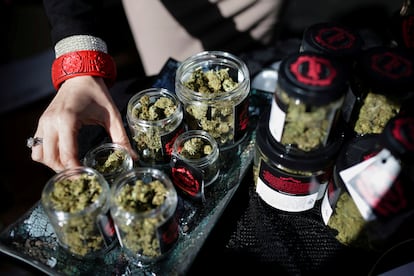A hit like Coca-Cola: The cannabis industry generates $40 billion
The approval of the drug’s recreational and medicinal consumption in dozens of states over the last decade has been accompanied by benefits like destigmatization and the growth of a multi-million-dollar industry, but problematic use and the continued incarceration of individuals on possession charges tarnish its successful narrative

The streets of New York are full of the unmistakable smell of marijuana. Not to mention, those of Los Angeles, San Francisco, Chicago and Atlanta. Since Colorado legalized recreational consumption a decade ago, subsequent states have fallen like dominoes, and today, 40 have legalized at least medical consumption, with 24 giving the OK to recreational. Such has been the rise in usage that, for the first time, its daily consumption has risen above that of alcohol throughout the country. With this boom have arrived multiple and varied pros, from the destigmatization of consumption to the growth of a multi-million-dollar industry that is an important source of tax revenue. That of cannabis is without a doubt a successful economic and political story, but it has its shadowy corners, such as problematic consumption and the blind eye that has been turned to the thousands of individuals who remain incarcerated on past possession offenses.
The percentage of U.S. residents who are regular marijuana smokers has more than doubled since 2013, according to Gallup. Back then, 7% of adults said they smoked regularly. Now, the number approaches 17%, some 44 million people. Another recent study adds that nearly half of those respondents report consuming cannabis daily or almost daily, which means that for the first time in history, more people ingest marijuana every day than alcohol; although it is possible that this rise is due to a greater openness to reporting consumption. Still, and despite the fact that it is difficult to make comparisons to other countries due to a lack of data, from what we know, the United States is among the biggest consumers of cannabis on the planet.
This is no minor development in a country that, throughout the 20th century, followed the prohibitionist model, first with alcohol and then other drugs. Marijuana in particular was the target of alarmist, misleading and, above all, stigmatizing campaigns that climaxed in the 1980s and 1990s. The very word “marijuana” serves as the perfect example. The term was popularized in the United States in the ‘40s, when it served to highlight the link between cannabis with the era’s Mexican migrant population. But from the beginning of this century and particularly, since 2014, public opinion on cannabis access has changed profoundly: while in 2000, some 30% supported legalization, a number that had held steady for nearly 30 years, today, nearly 70% of U.S. residents are in favor.
But it’s one thing is to legalize and regulate and another to legalize and commercialize, says Doctor Deepak D’Souza, director of the Yale Center for the Science of Cannabis and Cannabinoids. “It is the commercialization of cannabis that will drive the rates of cannabis use up. The cannabis industry is in the billions and is only increasing. The bottom line for commercial entities is to sell more product, but we need to remind ourselves about the impact of the commercialization of tobacco — that was the game changer.”
Dr. D’Souza is referring to the level of availability of cannabis products, but also to their marketing. It’s interesting to consider that, one on hand, while 54% of U.S. residents live in a state where recreational marijuana is legal, 79% live in a county with at least one dispensary (as stores that specialize in the cannabis products are known). Such variation points to the difference between legalization and commercialization. On the other hand, it’s important to keep in mind that, aside from smokable flower, a seemingly infinite number of unregulated THC-containing products like candies and drinks are often sold in colorful packaging that renders them nearly indistinguishable from child-friendly wares that do not contain cannabis. Herein lies another challenge of over-commercialization.
At the moment, the ringing of cash registers appears to have drowned out such voices of caution as that of D’Souza’s. According to Statista, the U.S. cannabis industry will generate $40 billion in 2024, up from $7.6 billion in 2016, the beginning of the legalization era. By 2028, it is expected to rise to $67 billion. That’s no small feat. Today’s numbers double the earnings of the U.S. chocolate industry, and hover close to the nationwide profits of Coca-Cola.
Consequently, the development of an entire multi-million-dollar market has also translated into an exponential rise in tax revenue in states where the drug has been legalized. In 2014, states collected around $70 million, largely from the medicinal cannabis market; in 2023, that tax revenue had risen to $4 billion thanks to all the states that have instituted some kind of legal industry. Such fiscal profits provide little incentive to exercise caution when it comes to promotion of cannabis products, particularly since the industry is also responsible for creating thousands of jobs throughout the country.
The shadows of mental health, road safety and incarceration
But though there are nearly no financial motivations for being critical of cannabis, arguments do abound; principally, when it comes to health. “Cannabis use is associated with both short- and long-term consequences. By short-term consequences, I am referring to those effects that occur immediately after consuming cannabis. The typical effects of cannabis, and the reason why most people use it, is to relax, reduce anxiety, promote sleep, facilitate social interactions, etc. But some acute effects of cannabis may negatively impact everyone. For example, cannabis impairs psychomotor coordination which could interfere with operating a motor vehicle,” says D’Souza. The limited studies that have been carried out suggest that there is a correlation between legalization and a rise in deaths caused by road accidents by nearly 10%.
And in the medium and long term, there are other risks that have to do with addiction and mental health. These appear to be linked to greater rates of use, but could also be associated with levels of THC — the psychoactive component of cannabis — that are on the rise. In recent decades, THC content has grown from an average of 4% in 1995 to 17% in 2017, a number that is probably higher today. As if that weren’t enough, there are also products like cannabis concentrates, also known as dabs, and legal edibles that can have up to 90% THC.
“There are converging lines of evidence supporting a link between cannabis exposure and the risk for schizophrenia. The earlier the use, the heavier the use, and the use of more potent forms seems to confer the greatest risk. There is also a greater risk for bipolar disorder, major depression and suicide… One might use the same analogy for smoking and lung cancer — not all smokers develop lung cancer and not all those with lung cancer have smoked cigarettes,” says D’Souza, who finds that such correlations present compelling evidence of the risks of such cannabis consumption.
The more extreme cases to which he refers, of psychosis and suicide linked to the problematic use of cannabis, are on the rise, according to the few studies that exist, especially among people who began regular consumption in adolescence, when the brain is still developing and is more vulnerable as a result. Nonetheless, it’s important to keep in mind that there are important genetic factors linked to all these conditions. And that, despite these risks, moderate consumption of marijuana involves notably few physical, psychological and social risks when compared to other, harder drugs, and even with alcohol and tobacco.
Beyond health, the greatest stain on the triumph of legal cannabis is retroactive: there are still thousands of people who have been incarcerated across the country for cannabis-related crimes. Although there have been few of such prison sentences handed down since 2017, current data suggests that this total is close to 32,000, though such numbers offer a limited degree of exactitude due to the difficulties in classifying certain offenses.
President Biden has addressed the subject on several occasions. “No one should be jailed for using or possessing marijuana,” he said a few months ago, words reflecting popular opinion on the subject. During an electoral year in which the votes of young people and people of color could be key, the president, who is up for re-election, has used such statements in an attempt to drum up support. There are unconfirmed rumors that in the next few months, Biden will sign an order releasing thousands of individuals who have been incarcerated for minor crimes like small-time possession.
Beyond electoral calculations, such rumbles indicate an awareness that the loose ends left in the wake of a poorly planned, economically motivated legalization process must be tied up. In the same vein, the imminent rescheduling of cannabis from a Schedule I controlled substance — the most restricted category, assigned to drugs that ostensibly have no medical use, like heroin — to Schedule III — a looser classification that would place cannabis alongside substances like ketamine and anabolic steroids — aims to achieve consistency between state and federal laws. The main effect such a change would have is to substantially free up possibilities for conducting a myriad of detailed studies on the potential uses of cannabis, and also its risks.
Ten years since the first legal recreational marijuana was sold in the United States, the cannabis boom is just beginning.
Sign up for our weekly newsletter to get more English-language news coverage from EL PAÍS USA Edition
Tu suscripción se está usando en otro dispositivo
¿Quieres añadir otro usuario a tu suscripción?
Si continúas leyendo en este dispositivo, no se podrá leer en el otro.
FlechaTu suscripción se está usando en otro dispositivo y solo puedes acceder a EL PAÍS desde un dispositivo a la vez.
Si quieres compartir tu cuenta, cambia tu suscripción a la modalidad Premium, así podrás añadir otro usuario. Cada uno accederá con su propia cuenta de email, lo que os permitirá personalizar vuestra experiencia en EL PAÍS.
¿Tienes una suscripción de empresa? Accede aquí para contratar más cuentas.
En el caso de no saber quién está usando tu cuenta, te recomendamos cambiar tu contraseña aquí.
Si decides continuar compartiendo tu cuenta, este mensaje se mostrará en tu dispositivo y en el de la otra persona que está usando tu cuenta de forma indefinida, afectando a tu experiencia de lectura. Puedes consultar aquí los términos y condiciones de la suscripción digital.
More information

‘Mamá Cultiva’: the struggle of Argentinian women who grew cannabis for their sick children
Archived In
Últimas noticias
Most viewed
- Sinaloa Cartel war is taking its toll on Los Chapitos
- Oona Chaplin: ‘I told James Cameron that I was living in a treehouse and starting a permaculture project with a friend’
- Reinhard Genzel, Nobel laureate in physics: ‘One-minute videos will never give you the truth’
- Why the price of coffee has skyrocketed: from Brazilian plantations to specialty coffee houses
- Silver prices are going crazy: This is what’s fueling the rally










































